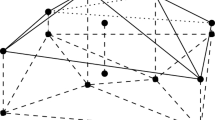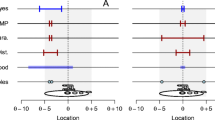Abstract
“Computing the pessimism” means bounding the overestimation produced by an inclusion function. There are two important distinctions with classical error analysis. First, we do not consider the image by an inclusion function but the distance between this image and the exact image (in the set-theoretical sense). Second, the bound is computed over a infinite set of intervals.
To our knowledge, this issue is not covered in the literature and may have a potential of applications. We first motivate and define the concept of pessimism. An algorithm is then provided for computing the pessimism, in the univariate case. This algorithm is general-purpose and works with any inclusion function. Next, we prove that the algorithm converges to the optimal bound under mild assumptions. Finally, we derive a second algorithm for automatically controlling the pessimism, i.e., determining where an inclusion function is accurate.
Similar content being viewed by others
References
Bellman, R.: Dynamic Programming, Princeton University Press, 1957.
Benhamou, F., McAllester, D., and Van Hentenryck, P.: CLP(intervals) Revisited, in: International Symposium on Logic Programming, MIT Press, 1994, pp. 124–138.
Cormen T.H., Leiserson C.E., Rivest R.L. (1990) Introduction to Algorithms. MIT Press, Cambridge
Garloff J., Jansson C., Smith A.P. (2003) Lower Bound Functions for Polynomials. J. Comput. Appl. Math. 157 (1): 207–225
Jaulin, L., Kieffer, M., Didrit, O., and Walter, E.: Applied Interval Analysis, Springer, 2001.
Kearfott, R. B.: Rigorous Global Search: Continuous Problems, Springer, 1996.
Makino K., Berz M. (2003) Taylor Models and Other Validated Functional Inclusion Methods. International Journal of Pure and Applied Mathematics 4 (4): 379–456
Moore, R.: Interval Analysis, Prentice Hall, 1966.
Neumaier, A.: Interval Methods for Systems of Equations, Cambridge University Press, 1990.
Ratschek, H. and Rokne, J.: Computer Methods for the Range of Functions, Halsted Press, 1984.
Revol N., Rouillier F. (2005) Motivations for an Arbitrary Precision Interval Arithmetic and the MPFI Library. Reliable Computing 11 (4): 275–290
Van Hentenryck P., Michel L., Deville Y. (1997) Numerica: A Modeling Language for Global Optimization. MIT Press, Cambridge
Author information
Authors and Affiliations
Corresponding author
Rights and permissions
About this article
Cite this article
Chabert, G., Jaulin, L. Computing the Pessimism of Inclusion Functions. Reliable Comput 13, 489–504 (2007). https://doi.org/10.1007/s11155-007-9044-7
Received:
Accepted:
Published:
Issue Date:
DOI: https://doi.org/10.1007/s11155-007-9044-7




